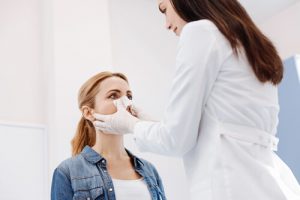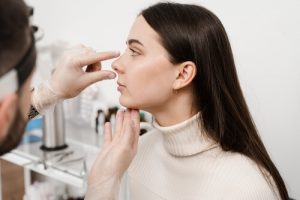Rhinoplasty is often referred to as a “nose job” or “nose reshaping” by patients, but many may not realise it can also be called nose reduction surgery. This specialised plastic surgery procedure repairs both the functional and aesthetic issues of the nose, simultaneously correcting breathing impairments due to structural defects. Ultimately, rhinoplasty enhances facial harmony and improves the proportions of your nose for an improved look you’ll love!
For both women and men, rhinoplasty – commonly known as nose reduction surgery – is becoming increasingly sought after. This type of procedure aims to enhance the look of your nose by adjusting its size, shape, and function; not only that, but it can also be used to right defects caused by birth issues, illness, or an accident. Let us help you answer any queries about what goes into a nose reduction surgery, so you have all the information needed when making up your mind about whether it’s something for you!
Rhinoplasty surgery: Is it for everyone?
In general, candidates for rhinoplasty should be done growing. For example, facial growth in teens and young adults can affect the look and function of the nose over time. The exception would be pediatric patients who have a facial birth defect, such as a cleft palate.
Additionally, patients should be in good overall health and should not smoke because smoking can lead to poor blow flow and increase the risk of tissue damage. Rhinoplasty is possible for teens who understand the procedure and have full parental consent. Ideally, girls should be at least 15 or 16 years old before having a procedure; boys should be at least 17 or 18. If combined with a septoplasty (straightening of the septum), this procedure can improve a patient’s self-confidence and breathing.
What Are the Benefits of Nose Reduction Surgery?

The primary benefit of nose reduction surgery is improved facial aesthetics. This can greatly impact self-confidence as it can enhance a person’s appearance. It can also help treat breathing problems such as sleep apnea or snoring caused by blocked or narrowed nasal passages. Additionally, correcting deformities due to birth defects can make eating and talking easier for some people.
How to prepare for your nose surgery
Before scheduling rhinoplasty, you meet with a surgeon. You discuss things determining whether the surgery will work well for you. This meeting usually includes:
Your medical history
The most important question is why you want the surgery and your goals. You also answer questions about your medical history. This includes a history of nasal blockages, surgeries, and any medicines you take. If you have a bleeding disorder like hemophilia, you may not be a candidate for rhinoplasty.
Physical exam
Your healthcare provider does a physical examination. Your facial features and the inside and outside of your nose are looked at.
The physical exam helps determine what changes need to be made. It also shows how your physical features, such as the thickness of your skin or the strength of the cartilage at the end of your nose, may affect your results. The physical exam is also important for determining how rhinoplasty will affect your breathing.
Photographs
Photographs of your nose are taken from different angles. The surgeon may use computer software to change the photos to show you possible results. These photos are used for before-and-after views and reference during surgery. Most importantly, the photos let you have a specific discussion about the goals of the surgery.
Discussion of your expectations
Talk about your reasons for surgery and what you expect. The surgeon can review with you what rhinoplasty can and can’t do for you and what your results might be. It’s normal to feel self-conscious talking about your appearance. But you must be open with the surgeon about your desires and goals for surgery.
Looking at the overall proportions of the face and profile is important before having rhinoplasty. If you have a small chin, the surgeon may speak with you about surgery to build up your chin. This is because a small chin can create the illusion of a larger nose. It’s not required to have chin surgery, but it may better balance your facial profile.
Once the surgery is scheduled, find someone to drive you home after the procedure if you’re having outpatient surgery. For the first few days after anesthesia, you may forget things, have a slower reaction time, and impaired judgment. Find a family member or friend to stay with you for a night or two to help with personal care as you recover from surgery.
Food and medications
Don’t take medicines with aspirin or ibuprofen (Advil, Motrin IB, others) for two weeks before and after surgery. These medicines may make you bleed more. Take only the medicines approved or prescribed by your surgeon. Avoid herbal remedies and over-the-counter supplements.
If you smoke or vape, stop. Smoking and vaping can slow healing after surgery and can result in tissue death. You could also get an infection.
What Is Involved in the Procedure?
Nose reduction surgery involves reshaping the structure of the nose by manipulating underlying cartilage and bone tissue. The surgeon may remove excess cartilage, trim certain areas of bone, use grafts from other parts of the body (such as ear cartilage) to increase size or change shape in certain areas, and reposition skin flaps during the procedure. Anesthesia will generally be used to ensure comfort throughout the operation.
Are there any Risks associated with Nose Reduction Surgery?
As with any surgical procedure, there are associated risks involved with nose reduction surgery, including infection and bleeding at the incision site. Scarring may also occur if an incision has to be made inside your nostrils. However, this will usually fade over time post-surgery if proper care is taken during recovery. Other potential risks include changes in sensation in the area around your nose, difficulty breathing through one nostril after surgery, the asymmetry between nostrils post-surgery, or dissatisfaction with results due to unrealistic expectations prior to undergoing surgery.
Is rhinoplasty a simple operation?
No. Rhinoplasty is a difficult operation. It is not just cosmetic surgery. This is due to several factors. First, the nose is a complicated 3D shape in the middle of the face. Changes made during rhinoplasty often are very small. But these changes can greatly affect how the nose looks and functions. Because these changes are small, so is the margin for error.
Swelling and the placement of local anesthetic in the skin distort the nose during surgery. That can hide many of the small changes made. Rhinoplasty also doesn’t have a regular plan or set order of steps. Surgeons personalise each operation to the needs of the patient.
What can I expect during recovery?

You must follow all instructions provided by your surgeon before and after your operation for things to go smoothly during your recovery following nose reduction surgery. Generally speaking, though, you should expect facial swelling and bruising after the operation, which should subside within two weeks post-surgery when most results become visible with continued improvement over months during recovery as swelling fades away completely, leaving behind desired results (which may require revisional surgeries).
After the procedure
After the surgery, you must rest in bed with your head raised higher than your chest. This reduces bleeding and swelling. Your nose may be stuffed up because of swelling. It could also be from the splints put inside your nose during surgery.
Most of the time, the internal bandages stay in place for 1 to 7 days after surgery. A splint may be taped to your nose for protection and support. It’s usually in place for about one week.
You may have a little bleeding and drainage of mucus and old blood for a few days after the surgery or after removing the dressing. A drip pad — a small piece of gauze held in place with tape — may be put under your nose to absorb drainage. Change the gauze as directed by your healthcare provider. Don’t put the drip pad tight against your nose.
You may be given other instructions to lower the chances of bleeding and swelling further. These should be followed for several weeks after surgery:
- Avoid intense physical activities such as aerobics and jogging.
- Take baths instead of showers while you have bandages on your nose.
- Don’t blow your nose.
- Sneeze and cough with your mouth open.
- Avoid certain facial expressions, such as smiling or laughing.
- Eat high-fibre foods, such as fruits and vegetables, to keep from getting constipated. Constipation can cause you to push hard, putting pressure on the surgery site.
- Brush your teeth gently to keep your upper lip from moving.
- Wear clothes that fasten in the front. Don’t pull clothing over your head, such as shirts or sweaters.
- Don’t rest eyeglasses or sunglasses on your nose for at least four weeks after the surgery. They can put pressure on your nose. You can use cheek rests or tape the glasses to your forehead until your nose has healed.
- Use SPF 30 sunscreen when you’re outside, especially on your nose. Too much sun may cause permanent discolouration on the skin of the nose.
You may have short-term swelling or black-and-blue colouration of your eyelids 2 to 3 weeks after the surgery. Swelling of the nose can last longer, sometimes up to a year. Eating less sodium will help the swelling go away faster. Don’t put anything such as ice or cold packs on your nose after surgery.
Your nose changes throughout your life whether you have surgery or not. For this reason, it’s hard to say when you have reached your final result from the surgery. However, most of the swelling is gone within a year.
Rhinoplasty Results

Small changes to your nose’s structure — even just a few millimetres — can make a big difference in your nose’s appearance. Most of the time, an experienced surgeon can get results both of you are satisfied with. But in some cases, the slight changes aren’t enough. You and your surgeon might decide to do a second surgery to make more changes. If this is the case, you must wait at least a year for the follow-up surgery because your nose can go through changes during this time.
How do I find a qualified surgeon?
When considering undergoing any kind of cosmetic procedure, always make sure that you find a qualified plastic surgeon who specialises in rhinoplasty procedures and who has evidence demonstrating their experience and success rate in executing these kinds of operations safely and successfully – such information should be available on their website directly or on independent review websites such as RealSelf, etc. For more information, please read more from our blogs and contact us so our friendly staff can schedule an appointment with our rhinoplasty surgeon.
References:
https://www.plasticsurgery.org/cosmetic-procedures/rhinoplasty
https://www.mayoclinic.org/tests-procedures/rhinoplasty/about/pac-20384532
https://my.clevelandclinic.org/health/treatments/11011-rhinoplasty
https://utswmed.org/medblog/rhinoplasty-nose-job/
https://www.nhs.uk/conditions/cosmetic-procedures/cosmetic-surgery/nose-reshaping-rhinoplasty/
https://www.webmd.com/beauty/cosmetic-procedures-nose-job-rhinoplasty
https://www.hopkinsmedicine.org/health/treatment-tests-and-therapies/nose-reshaping

